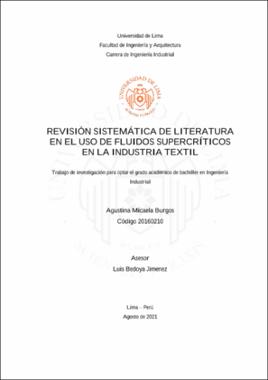Mostrar el registro sencillo del ítem
Revisión sistemática de literatura en el uso de fluidos supercríticos en la industria textil
| dc.contributor.advisor | Bedoya Jiménez, Luis | |
| dc.contributor.author | Burgos, Agustina Micaela | |
| dc.date.accessioned | 2021-10-21T21:10:01Z | |
| dc.date.available | 2021-10-21T21:10:01Z | |
| dc.date.issued | 2021 | |
| dc.identifier.citation | Burgos, A. M. (2021). Revisión sistemática de literatura en el uso de fluidos supercríticos en la industria textil [Trabajo de Investigación para optar el grado de Bachiller en Ingeniería Industrial, Universidad de Lima]. Repositorio Institucional de la Universidad de Lima. https://hdl.handle.net/20.500.12724/14332 | es_PE |
| dc.identifier.uri | https://hdl.handle.net/20.500.12724/14332 | |
| dc.description.abstract | En el presente trabajo se busca documentar mediante una revisión sistemática de literatura el potencial de los fluidos supercríticos en la industria textil y determinar si es probable alcanzar una producción más limpia con su uso, pues diversos científicos han afirmado que esta tecnología trae como beneficios una reducción en el consumo de agua y generación de efluentes contaminados, especialmente en el área de tintorería textil. Para ello, se realizó un análisis integral de los diversos artículos de investigación existentes referidos al tema de investigación. Para esta búsqueda se tomará en cuenta aquellos de ámbito global posteriores al 2013 que fueron seleccionados luego de implementar filtros basados en criterios objetivos. Acto seguido se procedió a analizarlos agrupando sus resultados y discutiéndolos. De este modo, se obtuvo como resultado principal que la tecnología que abarca el empleo de fluidos supercríticos es el sustituto perfecto de aquellos subprocesos textiles húmedos dentro de la tintorería que por su naturaleza produzcan muchos efluentes contaminados y posean un alto consumo de energía. Finalmente, se concluye que se puede emplear los fluidos supercríticos como método de la química verde para producir beneficios considerables para el medio ambiente y debido a la revisión realizada su aplicabilidad se vuelve más plausible. | es_PE |
| dc.description.abstract | The present work seeks to document through a systematic review of literature the potential of supercritical fluids in the textile industry and to determine whether it is likely to achieve cleaner production with their use, since several scientists have stated that this technology brings as benefits a reduction in water consumption and generation of contaminated effluents, especially in the area of textile dyeing. To this end, a comprehensive analysis of the various existing research articles on the subject of research was carried out. For this search, those of global scope after 2013 will be taken into account, selected after implementing filters based on objective criteria. Then, they were analyzed by grouping their results and discussing them. Thus, the main result was that the technology that includes the use of supercritical fluids is the perfect substitute for those wet textile sub-processes within the dyeing industry that by their nature produce many contaminated effluents and have a high energy consumption. Finally, it is concluded that supercritical fluids can be used as a method of green chemistry to produce considerable benefits for the environment and, due to the review carried out, their applicability becomes more plausible. | en_EN |
| dc.description.uri | Trabajo de investigación | |
| dc.format | application/pdf | |
| dc.language.iso | spa | |
| dc.publisher | Universidad de Lima | |
| dc.rights | info:eu-repo/semantics/openAccess | * |
| dc.rights.uri | https://creativecommons.org/licenses/by-nc-sa/4.0/ | * |
| dc.source | Repositorio Institucional - Ulima | |
| dc.source | Universidad de Lima | |
| dc.subject | Supercritical fluids | en_EN |
| dc.subject | Textile industry | en_EN |
| dc.subject | Fluidos supercríticos | es_PE |
| dc.subject | Industria textil | es_PE |
| dc.title | Revisión sistemática de literatura en el uso de fluidos supercríticos en la industria textil | es_PE |
| dc.type | info:eu-repo/semantics/bachelorThesis | |
| thesis.degree.level | Bachiller | |
| thesis.degree.discipline | Ingeniería Industrial | es_PE |
| thesis.degree.grantor | Universidad de Lima. Facultad de Ingeniería y Arquitectura | |
| dc.publisher.country | PE | |
| dc.type.other | Trabajo de investigación | |
| thesis.degree.name | Bachiller en Ingeniería Industrial | |
| renati.advisor.orcid | https://orcid.org/0000-0003-4718-054X | |
| renati.discipline | 722026 | |
| dc.identifier.isni | 0000000121541816 | |
| renati.author.dni | 1327798 | |
| renati.level | https://purl.org/pe-repo/renati/level#bachiller | * |
| renati.advisor.dni | 6774640 | |
| renati.juror | Vásquez Rivas Plata, Ruth | |
| renati.juror | Noriega Aranibar, María Teresa | |
| renati.juror | Cabrera Gil Grados, Ezilda | |
| renati.juror | Hernandez Gorritti, Wilfredo | |
| renati.type | https://purl.org/pe-repo/renati/type#trabajoDeInvestigacion | * |
| dc.subject.ocde | https://purl.org/pe-repo/ocde/ford#2.11.04 | |
| ulima.cat | OI |



